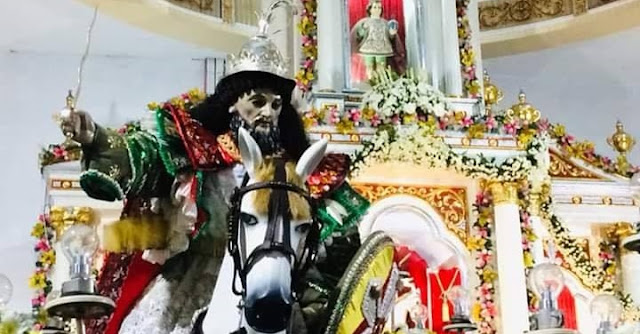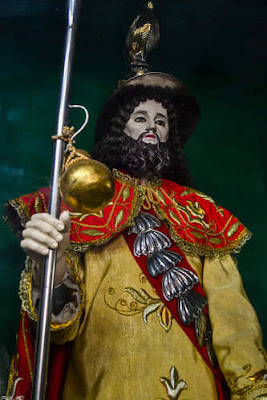Santiago Apostol de Plaridel - The Mighty Patron of Plaridel, Bulacan
 |
| Santiago Apostol de Plaridel |
In the historic municipality of Plaridel, Bulacan (then known as Quingua), known for its historic role during the Spanish and American regime, most notably the Battle of Quingua in 1899. The brave men and women of Plaridel took its pride to their miraculous patron saint that guided the municipality of Plaidel for centuries - Santiago Apostol. The devotion to Santiago Apostol de Plaridel was and still is the key devotion in this area for Santiago Apostol. or St. James the Great became a silent witness to the glorious and history of Plaridel, Bulacan.
The image
There were two images of Santiago Apostol venerated in Plaridel, Bulacan, the original image venerated in a chapel in Sipat and the parish image enshrined at the main altar of St. James the Great Parish in Plaridel, Bulacan. Both images presents St. James the Great riding on a horse, wearing an armor, brandishing a sword, trampling a Moor conqueror. In the parish of St. James, a de tallado version of the patron saint is enshrined at the main altar while the original centuries old de vestir image of Santiago Apostol of Plaridel is kept in the Sipat Chapel and it was this image that is used in processions, especially on his feast day December 29.
 |
| Santiago Apostol de Plaridel as a Pilgrim |
Santiago, or St. James the Apostle, was a Galilean and brother of St. John the Evangelist. St. James was one of only three apostles whom Jesus selected to bear witness to his Transfiguration and accompanied Jesus in Mount Olives in His agony. Following Christ's Ascension, James spread the Gospel across Israel and the Roman kingdom as well. He traveled and spread the Word for nearly forty years in Spain.
It is said that one day, as he prayed, The Blessed Virgin Mary appeared to him and asked him to build a church in her honor to hasten the conversion of the Spaniards to the Catholic faith and the Virgin left the jasper pillar where she stood. This vision would became the first known Marian apparition/bilocation in Church history and the devotion to Our Lady of the Pillar took root and spread all over Spain and its colonies.
Later, St. James returned to Jerusalem but was martyred for his faith by King Herod in 41 A.D, who decapitated him. Saint James the Greater is known as the first apostle to die.
As he was not allowed to be buried following his martyrdom, his remains were taken to Compostela, Spain, by some of his followers, who buried him. In 718 A.D, his remains were discovered and moved to a tomb in Santiago de Compostela. Today, his remains can still be found in the Cathedral of Santiago. Because Santiago de Compostela is the most frequently visited place pilgrims migrate to following Rome and Jerusalem, Pope Leo declared it a shrine.
 |
| The church image of Santiago Apostol de Plaridel |
There were two feast days that are kept in honor of St. James the Great, his Liturgical Feast every July 25 and December 30, the Spanish feast (in the old Mazorabic calendar observed in the Iberian Peninsula) to commemorate the translation of his relics from Jerusalem to Santiago de Compostela which is still observed in Spain and its colonies.
The origin of the devotion
The devotion to Santiago Apostol of Plaridel, Bulacan began when the Augustinian friars from Malolos Convent discovered a vast forest in 1581 then named as Binto; this would later be known as Quingua. Quingua was established by the Augustinian Friars of Malolos who initially named it "Encomienda Binto" (Barangay Bintog got its name from this settlement).
The Augustinians built a visita (chapel of ease) and placed it under the jurisdiction of Fray Mateo Mendoza, the prior of Malolos. The visita of Binto was elevated to an independent parish named Parroquia de Santiago Apostol, and the whole of Quingua was separated from Malolos and was created as a new pueblo on September 27, 1602.
 |
| The original image of Santiago Apostol de Plaridel |
When the owners of Bahay na Bato died, the image became the possession of Tandang Sitang whose house was eventually turned into a barrio chapel, present home to Santiago's image in Sipat.
The "Salubong" Festival
A fiesta for horse lovers is the popular two-day celebration called “Pintakasi ng mga Caballero” or more popularly known as "Salubong" held before New Year's Eve in Plaridel, Bulacan. Its main attraction, however, is held on December 29 with a colorful parade of cocheros, jockeys and other equine aficionados, followed by a tilbury race (horse-drawn chariots for two), whose participants include movie stars, luminaries of the province and government officials. The 400 year old tradition became one of the most awaited in Plaridel in honor of the Feast of the Translation of the relics of St. James to Spain. Multitudes of devotees flock to Plaridel every year to witness and participate in this colorful festivities.
The Fiesta ritual preceded by an early morning mass on December 29 at the chapel of Barangay Sipat as, “the traditional salubong.” Featured are race studs and the patient horses of caritelas and tilburies with their owners seeking blessing during the translacion or transfer of their patron saint to the parish. The procession is called "Salubong" because Santiago's image tailed by groups of faithful including elderly women wearing kimona’t saya and buntal hats performing a ritual dance is met by the patron's other devotees halfway from Sipat to Plaridel Parish Church, in the town's poblacion.
 |
| Santiago Apostol de Plaridel during the "Salubong" Festival |
The devotion at present
The devotion to Santiago Apostol of Plaridel, Bulacan continues to be an intergral part in the every day life of the people of Plaridel, Bulacan and the have also imbibed to strong character of their beloved patron which they demonstrated during the crucial parts of our national history. His feast day remains one of the most popular and visited in Bulacan which shows that the devotion is very much alive even in modern times.
As we conclude this blogpost dedicated to Santiago Apostol de Plaridel, here is the prayer that the devotees pray in his honor to ask for his help and intercession:
Mahal na Patron naming Santiago Apostol, Mula sa pagiging mangingisda tinawag ka ng Panginoon Upang mamalakaya ng sangkatauhan na bubuo ng Kristiyanong Sambayanan. Tulungan mo kami upang madinig Ang tawag ni Kristo sa aming buhay. Naging saksi ka sa mga mahahalagang pangyayari Sa buhay ni Hesus. Makita nawa namin sa aming paligid ang masaganang Pagpapala ng Panginoon. Sa iyong buhay, tinanggap mo ang kalis ng paghihirap. Tulungan mo kami na maging matatag Sa gitna ng mga pagsubok At ng hamon ng buhay.
Tulungan mo kami sa aming mga pangangailangan, (Banggitin ang sariling kahilingan)
Pagalingin mo ang aming karamdaman Patatagin mo kami sa gitna ng aming kahinaan. Dinala mo ang Mabuting Balita sa ibang bayan: Makatulong nawa kami sa pagpapalaganap ng Simbahan Sa aming paglalakbay, ikaw nawa ay aming maging gabay Upang ang lahat ng tukso at kapahamakan na dulot ng Kasalanan ay aming mapagtagumpayan, Nang sa gayon kami ay makarating sa makalangit na Tahanan.
Makasunod nawa kami kay Kristo, Tulad ng pagsunod mo ng buong katapatan Hanggang sa huling sandal n gaming buhay.
Santiago Apostol, Ipanalangin mo kami
References:
Butler, Alban,(1999), "Lives of the Saints", TAN Books, USA.
Galende, Pedro (2007), "Philippine Church Facades". Vibal Publishing House, Inc.
Cabigas, Estan. "Visita Iglesia: The Old Churches of Bulacan (Part 1 of 2)". simbahan.net. Retrieved on February 28, 2020.
St. James Parish Fiesta Committee, (2010), "Pistang bayan: Disyembre 29-30." Santiago Apostol Parish, Plaridel, Bulacan.
Special credits to the owner of the photographs used in this blogpost and to Mr. John Patrick Castro for providing the narrative and photos of Santiago Apostol de Plaridel.
+AM+DG+





Comments
Post a Comment